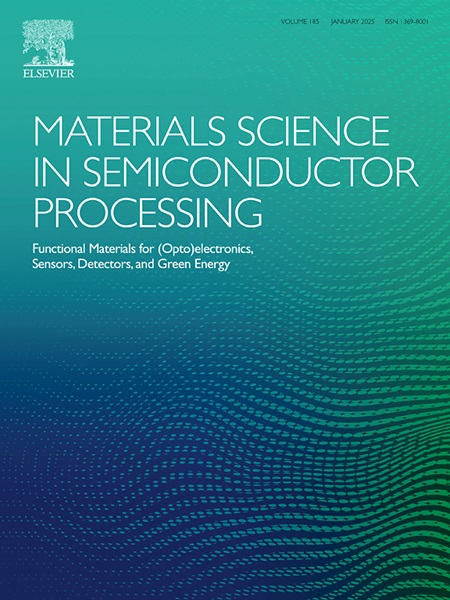Epitaxial lateral overgrowth of single crystal diamond through self-assembled highly ordered porous colloidal SiO2 opal mask
IF 4.2
3区 工程技术
Q2 ENGINEERING, ELECTRICAL & ELECTRONIC
引用次数: 0
Abstract
Synthesis of diamond layers with reduced dislocation density is vital for diamond application in electronics and photonics. The method of epitaxial lateral growth (ELO) based on blocking the dislocations propagation by a patterned mask on the substrate, is promising to control the dislocations. Here, we demonstrate the epitaxial diamond growth using a novel type of the mask for diamond ELO, consisting of a few monolayers thick self-assembled periodic lattice of submicron SiO2 spheres (opal structure). The method is simple, and does not require a lithography technique for the pattern definition. The porous opal mask with SiO2 spheres of ≈240 nm diameter was deposited on HPHT diamond substrates, then the epitaxial film was grown from bottom by microwave plasma CVD in a CH4-H2-O2 gas mixture. After penetration through the void system, a continuous smooth diamond film formed on the surface of the opal layer. High resolution transmission electron microscopy (HRTEM), electron diffraction and electron back scattering diffraction unambiguously indicated the single crystal structure of the formed diamond film, which were analyzed also with Raman and photoluminescence spectroscopy. The realized ELO version is promising for growth of low-defect single crystal diamond material, provided a further improvement of the opal mask colloidal templating.

通过自组装高有序多孔胶体SiO2蛋白石掩膜实现单晶金刚石的外延横向过度生长
降低位错密度的金刚石层的合成对于金刚石在电子和光电子领域的应用至关重要。基于在衬底上用图案掩膜阻断位错传播的外延横向生长(ELO)方法有望控制位错。在这里,我们展示了使用一种新型的金刚石ELO掩膜的外延金刚石生长,该掩膜由几个单层厚的自组装周期晶格的亚微米SiO2球体(蛋白石结构)组成。该方法很简单,并且不需要光刻技术来定义图案。在HPHT金刚石衬底上沉积了直径约240 nm的SiO2多孔蛋白石掩膜,然后在CH4-H2-O2混合气体中采用微波等离子体CVD从底部生长外延膜。穿透孔洞系统后,在蛋白石层表面形成连续光滑的金刚石膜。高分辨率透射电子显微镜(HRTEM)、电子衍射和电子背散射衍射明确表明了所形成的金刚石膜的单晶结构,并用拉曼光谱和光致发光光谱对其进行了分析。所实现的ELO版本为低缺陷单晶金刚石材料的生长提供了前景,为蛋白石掩模胶体模板的进一步改进提供了依据。
本文章由计算机程序翻译,如有差异,请以英文原文为准。
求助全文
约1分钟内获得全文
求助全文
来源期刊

Materials Science in Semiconductor Processing
工程技术-材料科学:综合
CiteScore
8.00
自引率
4.90%
发文量
780
审稿时长
42 days
期刊介绍:
Materials Science in Semiconductor Processing provides a unique forum for the discussion of novel processing, applications and theoretical studies of functional materials and devices for (opto)electronics, sensors, detectors, biotechnology and green energy.
Each issue will aim to provide a snapshot of current insights, new achievements, breakthroughs and future trends in such diverse fields as microelectronics, energy conversion and storage, communications, biotechnology, (photo)catalysis, nano- and thin-film technology, hybrid and composite materials, chemical processing, vapor-phase deposition, device fabrication, and modelling, which are the backbone of advanced semiconductor processing and applications.
Coverage will include: advanced lithography for submicron devices; etching and related topics; ion implantation; damage evolution and related issues; plasma and thermal CVD; rapid thermal processing; advanced metallization and interconnect schemes; thin dielectric layers, oxidation; sol-gel processing; chemical bath and (electro)chemical deposition; compound semiconductor processing; new non-oxide materials and their applications; (macro)molecular and hybrid materials; molecular dynamics, ab-initio methods, Monte Carlo, etc.; new materials and processes for discrete and integrated circuits; magnetic materials and spintronics; heterostructures and quantum devices; engineering of the electrical and optical properties of semiconductors; crystal growth mechanisms; reliability, defect density, intrinsic impurities and defects.
 求助内容:
求助内容: 应助结果提醒方式:
应助结果提醒方式:


